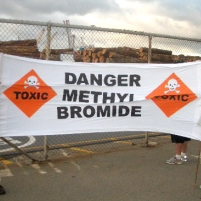The Pesticide that Won’t Go Away…Watch Your Strawberries
Friday, September 09, 2011
 (photo: theknowledgecore.files.wordpress.com)
(photo: theknowledgecore.files.wordpress.com)
Methyl bromide, a hazardous pesticide that most farmers were supposed to stop using six years ago, is still being sprayed in large quantities in parts of California.
An international agreement called for the phaseout of methyl bromide by 2005. But the treaty’s fine-print allowed for certain growers, such as strawberry farmers, to continue using the chemical, which has been linked to birth defects and other health problems.
According to the latest figures, more than five million pounds of the pesticide were sprayed in 2009, representing only a 50% reduction in use since 2000.
In some agricultural counties, levels of methyl bromide are almost as high as they were a decade ago. Monterey County, the state’s main strawberry production area, has only cut its use by 24% from 10 years ago (from 1.7 million pounds in 1999 to 1.3 million pounds in 2009).
The situation is similar in Santa Cruz County, which dropped its use from 564,000 pounds to 400,000 pounds.
In San Luis Obispo County, use of the chemical has actually gone up, from 110,000 pounds in 1999 to 125,000 pounds in 2009.
-Noel Brinkerhoff
Banned Pesticide Use Remains High in CA Strawberry Fields (by Ngoc Nguyen, New America Media)
Pesticide Problem: Exposure Ups Prostate Cancer Risk (by Heather Volk and Wendy Hessler, Environmental Health News)
The Phaseout of Methyl Bromide (U.S. Environmental Protection Agency)
- Top Stories
- Unusual News
- Where is the Money Going?
- Controversies
- U.S. and the World
- Appointments and Resignations
- Latest News
- Trump to Stop Deportations If…
- Trump Denounces World Series
- What If China Invaded the United States?
- Donald Trump Has a Mental Health Problem and It Has a Name
- Trump Goes on Renaming Frenzy






Comments